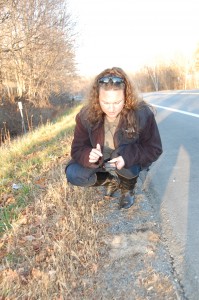You, roadkill, and your phone
I really enjoyed my afternoon with SUNY Plattsburgh wildlife ecologist Danielle Garneau. We drove around for almost 2 hours looking for road kill – and saw a skunk, 2 squirrels, two raccoons, a cat, and an unfortunate rabbit separated from its tail.
I must admit, I never thought of road kill as data. But I’m really interested in what we can learn from the animals – and so now I’m going to start tracking road kill too. If you’re interested in participating in the road kill citizen science project, click here* for more information.
Basically, you download EpiCollect, a free app for your phone. Then you set “RoadkillGarneau” as your project. Click new entry, and you’ll see a form. Fill out location, date, animal taxon, weather, etc. The app is a little buggy, but you’ll get the hang of it after a few tries. Don’t forget to save your entry and click SYNC to send the data to the project server.
If you don’t have a smart phone, you can still participate. Go to the project page, click on the map, and you can upload a picture and data about the roadkill you saw.
Be sure to be safe – don’t run out into oncoming traffic and only track animals you can safely access.
Happy, erm, hunting!
*11/29/12 Link is updated to Garneau’s professional website, which includes instructions on how to get started tracking roadkill. You can also contact her with questions: [email protected]
Tags: champlainvalley, environment









Its an interesting phenomenon that the ‘greater’ North Country is a center of road ecology research. Besides Danielle Garneau’s fine work at SUNY Plattsburgh, there are road ecology researchers at SUNY Potsdam (Glenn Johnson), St. Lawrence University (Erika Barthelmess), SUNY ESF (James Gibbs), Carleton University (Lenore Fahrig), University of Ottawa (Scott Findlay), and Concordia University (Jochem Jaeger). I conduct road ecology research at Clarkson. I don’t thing you are likely to find as many road ecology researchers anywhere in the world in a comparable short distance of each other.
Hi everyone,
Tom makes a really great point! What a dataset we’ll have in our region!
As a follow up, a better link to the project is off my webpage. The hyperlink in the above blog is to the data on the epicollect project page, but that won’t provide you w/ information on how to GET STARTED. If you want to participate, click on my webpage, download the download instructions for your phone type, and read a little more about our collection. At the bottom of the page is the google form for (live animal- WildlifeBlitzGarneau and dead animal RoadkillGarneau) projects for those w/o smartphones to participate.
https://sites.google.com/site/daniellegarneau/home/smartphone-apps-for-wildlife-observations
feel free to contact me with questions/help needs:
[email protected]
518-564-4073
What will we learn from this?
Great question, Original Larry. One of the most important things we can learn is what kinds of areas are most prone to animal – vehicle collisions. By learning what kinds of things are associated with segments of road that have high levels of road-kill, we can redesign roads or implement mitigation (fencing, under-ther-road culverts, vegetation alteration) that reduces the risk of vehicle-animal collisions. Insurance agencies care, because of the enormous cost in terms of property damage and injuries / deaths caused by animal-vehicle collisions. Environmental managers care, because road mortality and barriers caused by roads and road traffic can reduce or eliminate populations of animals. Many people would like to see ways to reduce road mortality simply because they care about the welfare of animals.
well stated Tom. Additionally, knowing patterns of animal movement to special habitats needed for their life history needs will allow us to better protect those special spots to help those populations in the long-term. Tom’s work with Clarkson students and colleagues on turtles in the North Country is a fine application of this sort of work. Drive west on Rt 56 from Canton to Ogdensburg, NY and you’ll see evidence of their work to help the herps!
Than you, Tom & Danielle